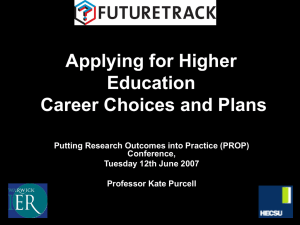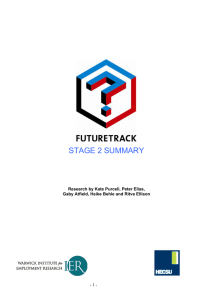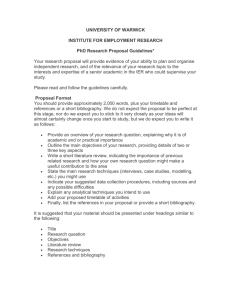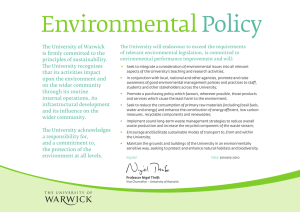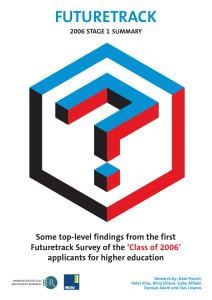B U L L E T I N plans, aspirations and realities
advertisement
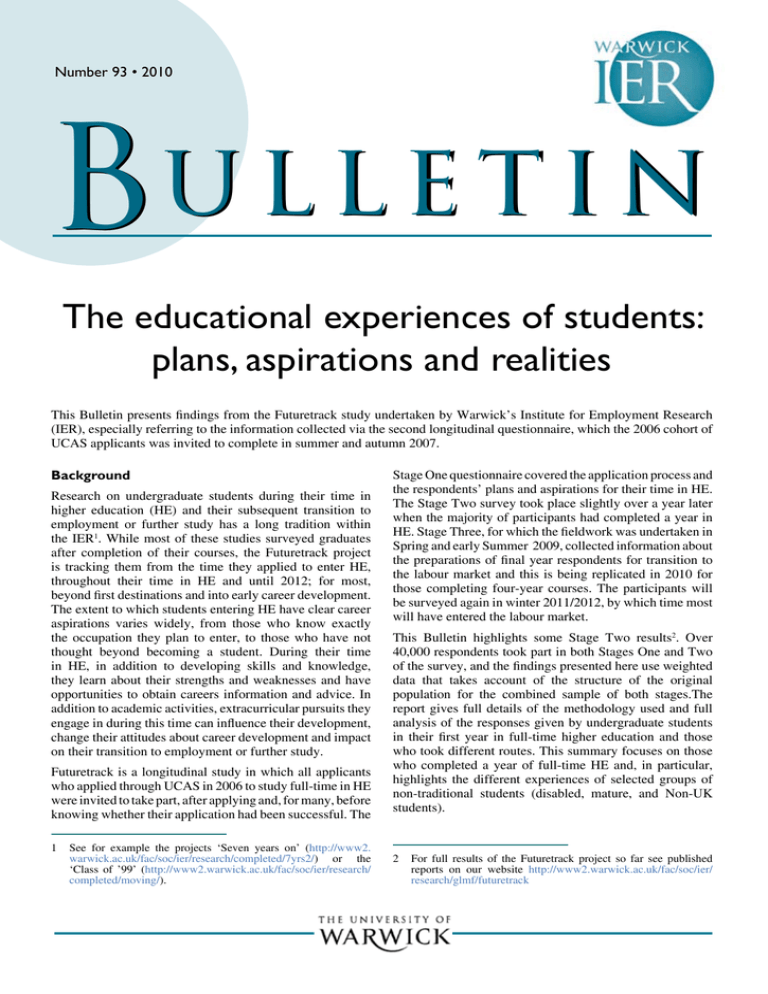
Number 93 • 2010 BU L L E T I N The educational experiences of students: plans, aspirations and realities This Bulletin presents findings from the Futuretrack study undertaken by Warwick’s Institute for Employment Research (IER), especially referring to the information collected via the second longitudinal questionnaire, which the 2006 cohort of UCAS applicants was invited to complete in summer and autumn 2007. Background Research on undergraduate students during their time in higher education (HE) and their subsequent transition to employment or further study has a long tradition within the IER1. While most of these studies surveyed graduates after completion of their courses, the Futuretrack project is tracking them from the time they applied to enter HE, throughout their time in HE and until 2012; for most, beyond first destinations and into early career development. The extent to which students entering HE have clear career aspirations varies widely, from those who know exactly the occupation they plan to enter, to those who have not thought beyond becoming a student. During their time in HE, in addition to developing skills and knowledge, they learn about their strengths and weaknesses and have opportunities to obtain careers information and advice. In addition to academic activities, extracurricular pursuits they engage in during this time can influence their development, change their attitudes about career development and impact on their transition to employment or further study. Futuretrack is a longitudinal study in which all applicants who applied through UCAS in 2006 to study full-time in HE were invited to take part, after applying and, for many, before knowing whether their application had been successful. The 1 See for example the projects ‘Seven years on’ (http://www2. warwick.ac.uk/fac/soc/ier/research/completed/7yrs2/) or the ‘Class of ’99’ (http://www2.warwick.ac.uk/fac/soc/ier/research/ completed/moving/). Stage One questionnaire covered the application process and the respondents’ plans and aspirations for their time in HE. The Stage Two survey took place slightly over a year later when the majority of participants had completed a year in HE. Stage Three, for which the fieldwork was undertaken in Spring and early Summer 2009, collected information about the preparations of final year respondents for transition to the labour market and this is being replicated in 2010 for those completing four-year courses. The participants will be surveyed again in winter 2011/2012, by which time most will have entered the labour market. This Bulletin highlights some Stage Two results2. Over 40,000 respondents took part in both Stages One and Two of the survey, and the findings presented here use weighted data that takes account of the structure of the original population for the combined sample of both stages.The report gives full details of the methodology used and full analysis of the responses given by undergraduate students in their first year in full-time higher education and those who took different routes. This summary focuses on those who completed a year of full-time HE and, in particular, highlights the different experiences of selected groups of non-traditional students (disabled, mature, and Non-UK students). 2 For full results of the Futuretrack project so far see published reports on our website http://www2.warwick.ac.uk/fac/soc/ier/ research/glmf/futuretrack 2 Educational experience in the first year of fulltime higher education Over three quarters of Stage Two respondents had completed a year in higher education at the time of the Stage Two survey, of which almost 90 per cent had remained on the course they had started. The day-to-day experiences of being a student differ a great deal over the sample. On average, students estimated that they normally spent approximately 15 hours per week in timetabled lessons, tutorials, practical work or other activities supervised by a lecturer or other academic. In addition, they reported having been required to spend an average of 13 hours per week on other non-timetabled coursework or study related to their course. The main factor found to be associated with increased time spent in timetabled lessons, tutorials or practical work was age, with students over 21 and Asian students, EU and overseas students spending more time than average in classes. Students studying at general and specialist higher education colleges and highest tariff3 universities, and students studying Medicine and Dentistry and subjects allied to Medicine and Engineering and Technology, were more likely to spend more time in timetabled lessons, while students at high and medium tariff universities and students studying History and Philosophical studies and Linguistics and Classics were more likely to have relatively little contact time. Over the full sample, paid work during term-time was connected with relatively short hours spent in timetabled lessons. Two thirds of respondents did some paid work in the previous academic year, with – by a small majority – the largest group being those doing paid work during both term and vacations (36 per cent) and a very small number employed only during term. About a third of all respondents did not do any paid work at all. A higher probability of working during term-time was found for females; students aged between 21 and 25 years; students studying Social Sciences, Social Science combined with Arts, Mass Communication and Documentation, and Education; and students from lower socio-economic backgrounds. Students of Medicine and Dentistry were the least likely to have undertaken paid employment during their studies. When subject studied was taken into account, freedom to undertake paid work during term was clearly associated with time spent in timetabled learning and the self-reported workload of students. In general, most students were content with the tuition and learning support they received on their course and with the HEI environment in terms of access to library resources and web based facilities. In light of the levels of debt reported by respondents and the widespread take-up of student loans by this cohort of students, students’ views of the quality of education they obtained during their time in HE was a major 3 For more information regarding the Access tariff classification, see Purcell K., Elias P. and G. Atfield (2009): Analysing the relationship between higher education participation and educational and career development patterns and outcomes. issue. It was notable that UK-domiciled students were more likely than educational migrants to anticipate high debts, as figure 1 shows. Figure 1: Debt anticipated at end of course comparing UK, EU and other overseas students 60 Other overseas 50 EU UK 40 30 20 10 0 None Up to £4,999 £5,000£9,999 £10,000£14,999 £15,000£19,999 £20,000£25,000 Over £25,000 Source: Futuretrack 2006 combined dataset: accepted applicants, weighted. The most frequent forms of funding were loans, followed by personal savings and earnings from vacation work. Just under 70 per cent of Futuretrack respondents agreed (1-3 on a 1-7 scale) with the statement ‘Last session I managed my finances well’ but 58 per cent also agreed (1-3 on a 1-7 scale) with the statement ‘I am worried about the prospect of having to repay loans and debts when I have completed my course’. A substantial minority reported difficulties in paying essential costs (e.g. 43 per cent all or some of the time, in relation to buying course books and materials, and 28 per cent in paying for accommodation). Access to careers advice is highly relevant in terms of the current recession and the high financial investments students make. About half of the respondents stated that they had taken part in a careers event organised by the Careers Service for first year students. Most students (45 per cent) were aware of the Careers Service but had not visited it during their first year of study (directly, by telephone, or by logging onto its website) and about 18 per cent said that they were unaware of this service. Reasons given for the lack of knowledge of the Careers Service included the vocationality of the subject, which was connected to the necessity to get Careers Advice prior to entry of higher education; non-occupational intrinsic motivation for studying; and the postponement of Careers Advice to the last year of their studies. The longitudinal design of Futuretrack 2006 allowed an analysis of the process of career decision making, as career ideas expressed during the application process could be contrasted with experiences during the first year in higher education. At both stages of Futuretrack we asked respondents to rate themselves on a scale of 1-7, where 1 means ‘in terms of long-term career planning I have a clear 3 idea about what I want to do’ and 7 means ‘I have no idea what I want to do’. The responses were used to analyse change in students’ perceptions and approaches to careersdecision making and planning. Figure 2 compares responses to this question during the application process and after the first year in higher education. Figure 2: Changes in clarity about future career 30 After the first year in HE 25 During the application process Figure 3: Proportion of students from different ethnic groups living at home during their first year in HE Asian Bangladeshi Asian Pakistani Black Caribbean Black African Asian Indian White 20 Asian Chinese 15 10% 20% 30% 40% 50% 60% 70% 80% Source: Futuretrack 2006 combined dataset: accepted applicants, weighted. 10 5 0 1 2 3 4 5 6 7 * Where 1 means ‘I have a clear idea about occupation and qualifications required’ and 7 means ‘I have no idea’ Source: Futuretrack 2006 combined dataset: accepted applicants, weighted. During the application process a higher number of respondents had stated that they had a clear idea about what they wanted to do, but after their first year in HE, fewer stated that they knew exactly what they wanted to do after completing their course. The first year in higher education can be interpreted as a ‘reality shock’ (Millward, 2005:178) in which vocational and educational expectations are exposed to reality. Previously acquired knowledge and ideas are challenged by new influences and experience, sometimes including work experience. The context of first year undergraduate experience The majority of students in the Futuretrack cohort lived in student accommodation (i.e. university-owned halls of residence or other student flats), during their first year of study. However, almost a third lived at home, either alone or with family members. As would be expected, older students were more likely to live at home, but even in the youngest age groups (18 and under and 19 to 21), 20 per cent lived at home. Ethnicity was also positively related to whether a student was likely to be living at home. More than two-thirds of Bangladeshi-origin students lived at home, as did more than half of Pakistani-origin students, while only a quarter of white students did, as figure 3 shows. Students from lower social classes were also more likely to live at home, with 42 per cent of students from routine and manual backgrounds living at home during their first year in HE, compared to 34 per cent of students from an intermediate occupational background, and 24 per cent of those from a professional or managerial background. Students living at home tended to spend longer travelling to their classes, and were less likely to engage in extra-curricular activities at their HEI. Students at highest tariff universities were the most likely to take part in extracurricular activities at their HEI and the most likely to have been an office holder or student representative during their first year in HE. Thus, whether students live at home or migrate away from home to study is systematically associated with different experiences of being a full-time HE student. Exclusion from the kind of extra-curricular experiences employers value can limit accumulation of social and cultural capital that can be of use both in HE and in the labour market, so the exclusion of those from non-traditional backgrounds, by choice or circumstance, can have a farreaching impact on HE’s role in enhancing opportunity. Special groups of students (mature and disabled students, non-UK based students) There was some evidence of a lack of support for students who required special help, not only those with disabilities, but also students who came from non-traditional backgrounds. In this summary, we concentrate on three groups of students - mature students, disabled students, and non-UK based students - to look at their experiences during their first year in higher education. 4 Mature students Although officially defined as students aged 21 or over when they entered higher education in 2006, mature students are a heterogeneous group, ranging from students who have delayed entry to higher education for a few years to retired people making up for earlier lack of opportunity or adding to their qualifications in the third age. In our sample, about 13 per cent were classified as younger mature students (21 to 25 years old) and the 12 per cent were 26 years and older and classified as older mature students. These groups of mature students differed from the typical undergraduate in their accommodation and career planning. Existing family or community commitments meant that they tended to live further from their HEI, and participate less often in extracurricular activities. They were more likely to have a clear vocationally-related career plan from the outset of their course, and some were planning to return to jobs or organisations where they had worked prior to their study. Consequently, they were also less likely to plan further study. Disabled students Seven per cent of Stage Two respondents who had entered higher education in 2006 reported that they had a disability or long-term illness which restricted (or might be seen to restrict) their ability to do academic work. Dyslexia and mental health difficulties were the most commonly-reported disabilities cited by, respectively, a third and almost a quarter of all respondents who declared a disability or longterm illness. When asked to evaluate their experience of higher education, students with disabilities were less likely to agree that it had been a positive experience overall. They were less likely to have done paid work, but more likely than students without a disability to have done voluntary work. Non-UK based students The UK is one of the most popular destinations for nonUK students from Europe and other overseas countries, and students come to the UK from a very diverse range of countries. In addition to the UCAS classification of the origin of non-UK based students, we used their continent of birth to facilitate a more detailed analysis of non-UK based students. Only about half the accepted students from Africa completed their first year in HE in the UK, although about a quarter had accepted a deferred place to start their course in the following year, reflecting difficulties in arranging visas and funding. More than a third of African students found the standard of work on their course higher than they had expected and two thirds of African students reported that they were required to work harder than they had expected. By contrast, 80 per cent of accepted students from Asia completed their first year in higher education. Overseas students from Asia were the least likely to report undertaking any paid work during their first year of study. Half of all students from Asia planned to continue their studies and were the group most likely to plan to apply for a taught Master’s degree. Similar proportions of HE applicants from Europe and North America had gone on to complete a year in full-time study, and they tended to have similar expectations of workload and standard of work on their course to UK-domiciled students. Conclusion and outlook The longitudinal methodology used for this study has already provided valuable insights into the progression of students from application process to the first year in higher education. It is possible to track students, exploring a wide range of characteristics to discover those that are associated with different experiences of higher education. As the Futuretrack project progresses, it will be possible to relate these diverse experiences of HE to different transitions into employment, and ultimately to examine the impact higher education has on labour market outcomes. Given that the majority of the cohort that embarked on full-time HE in 2005-6 reach the end of their courses during a serious recession, they are likely to be faced with greater challenges in labour market integration than most previous generations of graduates, but their experiences have significant policy implications for future HE and labour market planning. References Millward, L. (2005) Understanding Occupational and Organizational Psychology, London: Sage Publications, New Delhi: Thousand Oaks. This Bulletin was produced by Heike Behle, Gaby Atfield and Kate Purcell. It summarises findings presented in the second Futuretrack report: Purcell, K. et al, (2009) Plans, aspirations and realities: taking stock of higher education and career choices one year on. Manchester: HECSU (November) http://www2.warwick.ac.uk/ fac/soc/ier/research/glmf/futuretrack/futuretrack_ stage_2_report_final_november_09.pdf. The Futuretrack project is managed by Professor Kate Purcell. The research team includes Gaby Atfield, Dr Heike Behle, Professor Peter Elias, Ritva Ellison and Caroline Hughes. For more information on this project email c.j.hughes@warwick.ac.uk For further information about other projects visit the IER website at www.warwick. ac.uk/ier or e-mail: ier@warwick.ac.uk WARWICK INSTITUTE for EMPLOYMENT RESEARCH University of Warwick Coventry CV4 7AL ier@warwick.ac.uk
